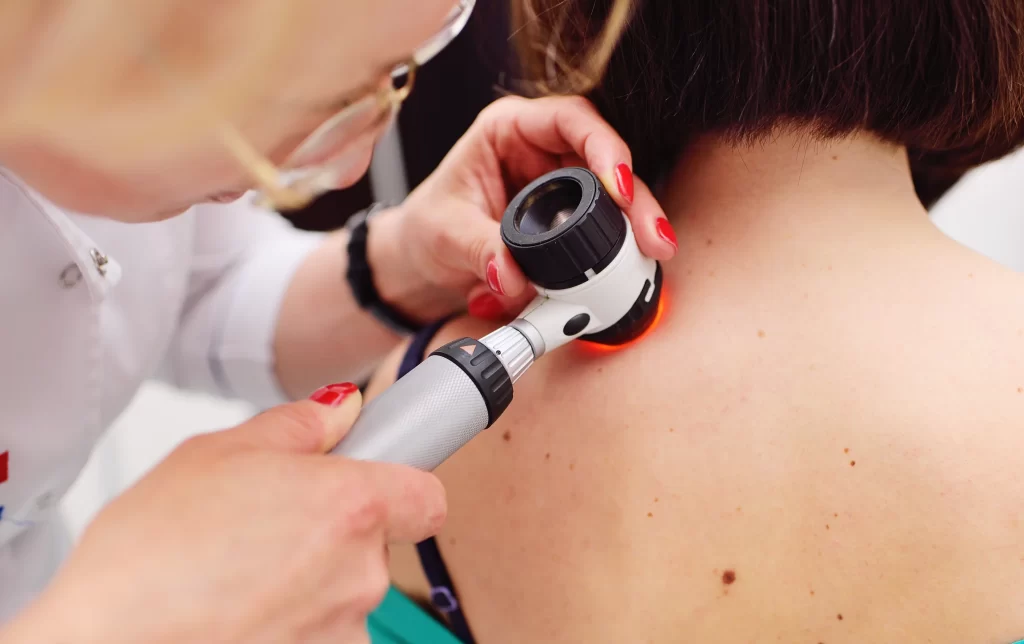There are several skin lesions that are very common and non-cancerous like moles. However, some moles can turn into cancer. Knowing what to look for when checking your child’s mole can help catch any cancerous moles early. Read on to learn more about moles and signs your child’s mole should get checked.
WHAT IS A MOLE
Moles are growths on the skin that are normally brown or black. Moles can appear anywhere on the skin, alone or in groups. Most moles appear in early childhood or during the first 25 years of a person’s life. It is normal to have between 10 and 40 moles by adulthood. As the years pass, moles can slowly change, becoming raised or changing in color. Some moles may not change at all, while others may slowly disappear over time.
WHAT CAUSES A MOLE
Moles can occur when cells in the skin grow in a cluster instead of being spread throughout the skin. These cells are called melanocytes, and they make the pigment that gives skin its natural color. Moles may darken after exposure to the sun, during the teen years and during pregnancy.
TYPES OF MOLES
Congenital Nevi: Congenital nevi are moles that are present at birth. These occur in about one in one-hundred people. These moles are more likely to develop into melanoma than moles that appear after birth.
Dysplastic Nevi: Dysplastic nevi are moles that are generally larger than average, bigger than a pencil eraser, and irregular in shape. They tend to have uneven color with dark brown centers and lighter, uneven edges. These moles are more likely to become melanoma. In fact, people who have ten or more dysplastic nevi have a higher chance of developing melanoma.
HOW DO I KNOW IF A MOLE IS CANCEROUS

Examine your skin and pay attention to areas of the skin that are often exposed to the sun, including your arms, face or chest. Knowing the ABCDEs are important when examining moles. If a mole displays any of the signs listed, have it checked immediately by a dermatologist. It could be cancerous.
- Asymmetry: One half of the mole does not match the other half.
- Border: The border or edges of the mole are ragged, irregular or blurred.
- Color: The color of the mole is not the same throughout or has shades of tan, brown, blue, red, white, or black.
- Diameter: The diameter of a mole is larger than the eraser of a pencil.
- Evolution: The mole is changing in shape, color, or size.
Melanoma is a type of skin cancer that causes the most deaths. It starts in the melanocyte cells that make pigment in the skin. It may begin as a mole that turns into cancer. This cancer may spread quickly. Melanoma often appears on fair-skinned people but is found on all skin types.
The majority of moles are not dangerous. Moles that are more likely to be cancer are those that look different than other moles and appear after the age of 25. If you notice changes in a mole’s height, color, shape or size, you should have a dermatologist evaluate it.
To learn more about skin cancer prevention, download our Guide to Preventive Skin Care below.
5 SIGNS YOUR CHILD’S MOLE SHOULD GET CHECKED
Moles on a child’s skin are generally nothing to worry about. As your child grows, the moles will naturally get bigger. Melanoma is rare in young children; however, if it is caught early, melanoma is highly treatable. The following are signs your child’s mole should be checked:
- Changing mole: It is normal for a mole to grow and it is also natural for a child’s mole to get darker or lighter. If a mole is growing quickly or looks different than others, these may be signs of melanoma. A dermatologist should examine any mole on your child’s skin that is growing or changing quickly or looks different than the rest.
- A mole that is dome-shaped, has a jagged border, or continues to change colors: If you see a raised, round growth on your child’s skin that is red, tan, pink, or brown, it is likely a Spitz nevus. This is a harmless mole that appears between ten and twenty years of age. A child can also be born with this type of mole. If your child has a raised, dome-shaped growth or a mole that has a jagged border or different colors, it should be examined by a dermatologist.
- Bleeding mole: A raised mole can become irritated. If a mole bleeds without reason, it should be checked. A mole that looks like an open sore can be worrisome. Bleeding or a break in the skin can be a sign of melanoma.
- Many moles: It is normal for a child or teenager to get new moles. By the time a child becomes an adult, it is common to have 12 to 20 moles. Some children who have lots of moles can get melanoma early in life. According to the American Academy of Dermatology, a study found that more than half of the 15 to 19-year-old patients with melanoma had at least 100 moles. Caught early, melanoma is highly treatable.
- Large moles: Most moles are round or oval spots that are smaller than the eraser of a pencil. Some children get larger moles. A large mole can be seven or more inches in diameter. A giant mole can cover part of a child’s body. Children with these types of moles are usually born with them. These moles can also develop shortly after birth.
Having a large or giant mole increases the child’s risk of developing melanoma. This risk is greater when the child is young. More than half of melanomas that develop are diagnosed by ten years of age. A child who has a large or giant mole should be under a dermatologist’s care.
HOW ARE MOLES TREATED
If a mole needs further evaluation, a dermatologist will do a biopsy by cutting or shaving out the entire spot so that it can be evaluated under a microscope. This is a simple procedure. If the mole is found to be cancerous, the dermatologist will cut out the area of skin, and stitching the wound closed.
HOW CAN OUR DERMATOLOGISTS HELP?
Moles on the skin are usually harmless, but not always. It is perfectly normal for moles to appear during childhood and for them to get bigger as a child gets older. It is also normal for these moles to get darker or lighter, and fade away. Melanoma is rare in children but that does not mean you should ignore some of the warning signs.
The Dermatology Center for Skin Health, PLLC, has 25 years of experience. Our priority is to deliver complete, compassionate care to our patients while educating and assisting them as they make decisions regarding the health of their skin.
Our dermatologists know that your skin health is important to you. If you think your child’s mole needs to be checked, give us a call.


